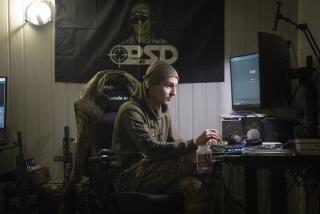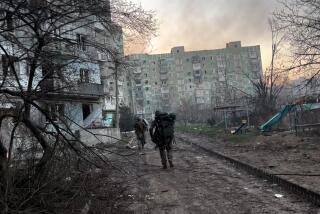Shedding armor to win the battle
TAGAB VALLEY, AFGHANISTAN — As the radio crackled with a report that nearby soldiers had come under attack, the mood among Georgia National Guard members in their heavily armored truck grew tense.
They were entering a stretch of road known as “the Gantlet” for its frequent small-arms fire and roadside bombs. Earlier in the summer, three members of the company were killed in a roadside blast not far away.
Staff Sgt. Rodney “Bull” Bettis gave the driver a warning: Don’t slow down.
Speeding up is a common response to the rising threat from roadside bombs all around Afghanistan, an instinctual response to mortal danger.
But the new U.S. and allied commander wants troops to think twice before barreling through Afghan villages and cities.
“We send a message that we don’t care about them, that our safety is more important than theirs,” Army Gen. Stanley A. McChrystal told his regional commanders during a morning briefing this summer.
McChrystal said he has his own convoy move with the traffic, perhaps going even a bit slower. He never waves other vehicles off the road.
“That is how I want this entire force to move,” he said.
One of McChrystal’s first acts was a directive tightening rules on airstrikes to limit civilian casualties. Despite allegations that a strike killed dozens of civilians Friday, the new rules have sharply reduced the number of deaths.
Overhauling the way alliance troops treat Afghans in everyday interactions represents the next step in rebuilding trust, McChrystal said at the briefing. Aggressive behavior could undermine the larger mission, he said.
“We send two messages: We send the message we don’t respect the Afghans and we send a more subtle message that we are scared,” McChrystal said. “This is a warrior culture. . . . If you walk around looking scared, they are not going to respect you.”
The commander’s guidance is becoming national policy. In a formal assessment of the military effort presented last week to President Obama, McChrystal said the United States military must change the way it operates in Afghanistan in part by ensuring that troops protect and show respect for Afghans.
As the new directives filter through the ranks, there is no doubt as to whether officers and troops will carry them out. But for some, the changes may seem to conflict with their first priority: keeping fellow soldiers and Marines safe.
--
Anxiety and fear
The chatter inside Bull Bettis’ MRAP -- a mine-resistant, ambush-protected vehicle -- is usually full of good- natured wisecracks and tales about characters back in Georgia.
But once in “the Gantlet,” the normally warm and spirited gunner, Sgt. Jim Wilson, turned grim. From inside the turret, where he mans the M240 and .50-caliber machine guns, Wilson’s thoughts turn to his three girls, ages 7, 8 and 9.
“If anything happens, tell my babies I love them,” he said.
But the rest of the crew did not want the jinx of such dark talk.
“Knock it off,” Bettis said.
“Yeah, knock it off,” echoed Capt. David Burris, the unit’s chaplain.
“I don’t want anything to happen,” Wilson replied. “But I just haven’t written the letter.”
The letter is the note soldiers write to their families in case they are killed. When soldiers are thinking about the letter, they are thinking about dying.
Even inside the thick steel of the MRAP’s armor, the threat of bombs along Afghanistan’s roads is real. With dozens of U.S. troops being killed by the devices each month, especially in the south of the country, there is every reason for soldiers to feel anxious.
The chaplain has come under attack twice in the short time he has been in Afghanistan. No one was seriously hurt, but the guardsmen jokingly argue about whether he is a protective talisman or a Taliban magnet. Still, when in peril, they turn to Burris for reassurance.
From the back of the MRAP, the chaplain piped up once more across the intercom.
“Yea, though I walk through the valley of the shadow of death, I will fear no evil: for thou art with me,” Burris said. “Thy .50-cal. and 240, they comfort me.”
The MRAP, a V-hulled truck, has protected the lives and limbs of soldiers as a successor to the Humvee, and allowed travel on roads thick with explosive devices. The problem is that Afghans are intimidated by the protective armor on the vehicles, according to some of McChrystal’s top military advisors.
An approaching armored vehicle such as the MRAP or Stryker can look menacing, and may remind Afghans of the Soviet army and its armored Hind helicopters.
“I call it a visceral problem,” said Cmdr. Jeff Eggers, a Navy SEAL serving as an advisor to McChrystal. “A Stryker coming around the corner may evoke a Hind gunship coming over the hill. But we are not the Soviets, not by a long shot.”
Many of McChrystal’s advisors have come to the view that technology in warfare is not always beneficial. Some cite an article by Army Lt. Col. Isaiah Wilson III and Princeton University professor Jason Lyall published this year in the journal International Organization called “Rage Against the Machines.” The article argues that as militaries grow more sophisticated, winning counter-insurgency campaigns becomes more difficult.
In a counter-insurgency, the most effective tactic is winning the respect of the local population, Eggers said.
“We have a short-term mind-set,” Eggers said. “In the short-term mind-set, it makes sense to armor up. But if we accept more short-term risk, we may have less long-term costs.”
Army Lt. Gen. David Rodriguez, who is in charge of day-to-day military operations in Afghanistan, said troops need to realize the limitations of their vehicles. The armor that protects them from roadside bombs also cuts off interaction with the public.
“When you get into an MRAP,” Rodriguez said, “you have one person who has the ability to connect to the people -- and that is up in the gunner’s seat.”
--
Tactical patience
Like most troops, the Georgia National Guard members talk a lot about violent confrontations with extremists. The morning after their nerve-racking drive through “the Gantlet,” squad members heard an explosion and tracked two fleeing men.
Quick decisions were made, said Jim Wilson, the gunner, recounting the chase later.
“Oh man, I was traversing down on them,” he said. “I could have had some Taliban.”
But Wilson did not fire. His gut told him that those were the men who had set off the bomb. But there was no direct evidence. And the two men were fleeing, not attacking his MRAP.
Wilson let them go.
Through eight years of war here, troops have learned that the decision not to shoot, although difficult, is often one of the most important they make. Now top commanders in Afghanistan want them to also think about changing how they act around Afghans, how they drive through villages and how much armor they wear.
“The real challenge is when to apply the great technology we have at the right places,” Rodriguez said. “It is like the decision of when to be tactically patient and when to be tactically aggressive. There is a time and place for each. And when you mix them up, there ends up being negative consequences.”
The problem is not the equipment itself, but how it is used, Rodriguez said. Used one way, a Stryker barrels through town and runs 20 people off the road. Used another, the vehicle pulls up outside a market, and eight U.S. infantry soldiers get out and mingle with the locals.
“It’s not the vehicle,” Rodriguez said. “It’s how you treat the people.”
It may be hard to convince soldiers, but in the long term they may be safer without their body armor and steel-hulled trucks.
“You can defeat IEDs through technology. You can defeat IEDs through more armor,” Eggers said, referring to roadside bombs, which are known as “improvised explosive devices.” “Gen. McChrystal wants people to think that you can also defeat IEDs by convincing the people not to let insurgents plant them in the roads.”
--
Hard looks
“Look out,” Wilson shouted from the gunner’s turret.
A young Afghan girl had darted into the street. The driver, Spc. Josh “Boxcar” Weaver, instantly pulled the heavy MRAP toward the center of the road, away from the girl. Bettis, the staff sergeant, radioed a warning to the rest of the convoy to watch out for children, then sighed in relief.
“She could have been hit,” Bettis said.
Weaver’s quick reflexes undoubtedly saved the girl. But had the convoy been moving more slowly, it might not have been as close a call.
Many of the people on the street watching the convoy offered hard stares. Perhaps the villagers were aligned with the Taliban. Perhaps they were just angry about being run off the road or having their children nearly run over.
From inside their MRAP, the soldiers will never know for sure.
--
More to Read
Sign up for Essential California
The most important California stories and recommendations in your inbox every morning.
You may occasionally receive promotional content from the Los Angeles Times.










